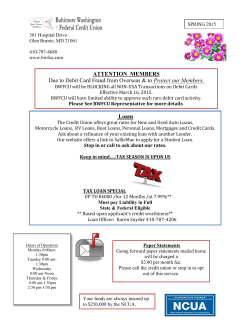
Reading Essential and Note-Taking Guide 4.2
Chapter 4, Section 2 (Pages 92–98) Sources of Loans and Credit As you read pages 92–98 in your textbook, complete this graphic organizer by filling in different types of lending institutions. 1. 3. Lending Institutions 2. 5. Types of Financial Institutions 34 (page 93) Before choosing a lender, a consumer shopping for a loan should compare the requirements, interest, and payment schedules of different institutions. Commercial banks offer loans along with a variety of services, such as checking and savings accounts. They control the largest amount of funds. They also transfer, or move, funds among businesses and individuals. Savings and loan associations (S&Ls) and savings banks are similar to commercial banks. S&Ls and savings banks offer mortgage loans and auto loans at a slightly lower interest rate than commercial banks. The other services offered by S&Ls and savings banks vary between institutions. Union members or company employees can take out loans from a credit union to which they belong. Because members own and run the credit union, they can offer a low interest rate. For some installment debts, consumers can take out loans from finance companies. Finance companies manage installment debts for retail stores and may lend money to people who are turned down by other lending agencies. However, they charge higher interest rates than other financial institutions. Chapter 4, Section 2 Copyright © by The McGraw-Hill Companies, Inc. If a consumer who has repaid previous loans very late wanted a loan to purchase a car, which financial institution would likely lend him the money? 4. Charge Accounts and Credit Cards As you read, compare charge accounts. 1. Regular Charge Account Advantage: Disadvantage: 2. Revolving Charge Account Advantage: Disadvantage: Copyright © by The McGraw-Hill Companies, Inc. 3. Installment Charge Account Advantage: Disadvantage: (page 95) Lenders offer another form of credit that consumers receive before they make a purchase. Credit cards and charge accounts give funds directly to people or businesses without the people or the businesses borrowing the funds first. Consumers can purchase goods or services from a specific company, such as a store, through a charge account. Charge accounts allow consumers to buy goods first and pay for them later. A regular charge account requires consumers to pay for all their purchases at the end of each 30-day, or monthly, period. A revolving charge account allows consumers to pay only some of the bill after 30 days, but the lender calculates the interest and adds it to the unpaid amount. In the meantime, consumers can continue to charge new items to their account within a set limit. People can purchase expensive items, such as kitchen cabinets or a home theater system, with an installment charge account. As with installment debt, people make equal payments over a set period of time. Credit cards are similar to charge accounts, but they can be used at many different types of stores and even at restaurants. Consumers can use the cards, such as Visa or Mastercard, to pay for purchases or to borrow funds up to a limit set by the creditcard company. Credit cards give consumers access to borrowed funds without having to apply for a loan. Debit cards are not the same as credit cards. Debit cards allow consumers to use money directly from their bank accounts, rather than loaned funds. Finance Charges and Annual Percentage Rates Before you read, write two questions you hope will be answered by the passage. 1. 2. Chapter 4, Section 2 (page 97) Both the finance charge and the annual percentage rate are the cost of the service of borrowing funds. However, lenders express each one in different ways. The finance charge is the cost of credit expressed in dollars and cents. Charge accounts may use the previous balance, the average daily balance, the adjusted balance, or the past-due balance to determine how much to charge for the cost of credit. This means finance charges vary a lot from one lending institution to another, depending on how the lender arrives at the amount to charge. The annual percentage rate (APR) is a percentage, such as 15 percent. It is the yearly cost of borrowing, regardless of the amount of funds. Since it is a percentage, consumers can easily comparison shop for a credit card by seeking the lowest APR offered. 35 Answer these questions to check your understanding of the entire section. 1. Describe three reasons why consumers might prefer a credit card to a charge account. 2. Why should consumers compare finance charges and interest rates offered by different financial institutions? Exposi tory Compare and contrast factors that consumers should consider when choosing credit lenders for buying clothes versus choosing credit lenders for buying a house. Consider types of credit as well as types of financial institutions. Copyright © by The McGraw-Hill Companies, Inc. 36 Chapter 4, Section 2
© Copyright 2024





















